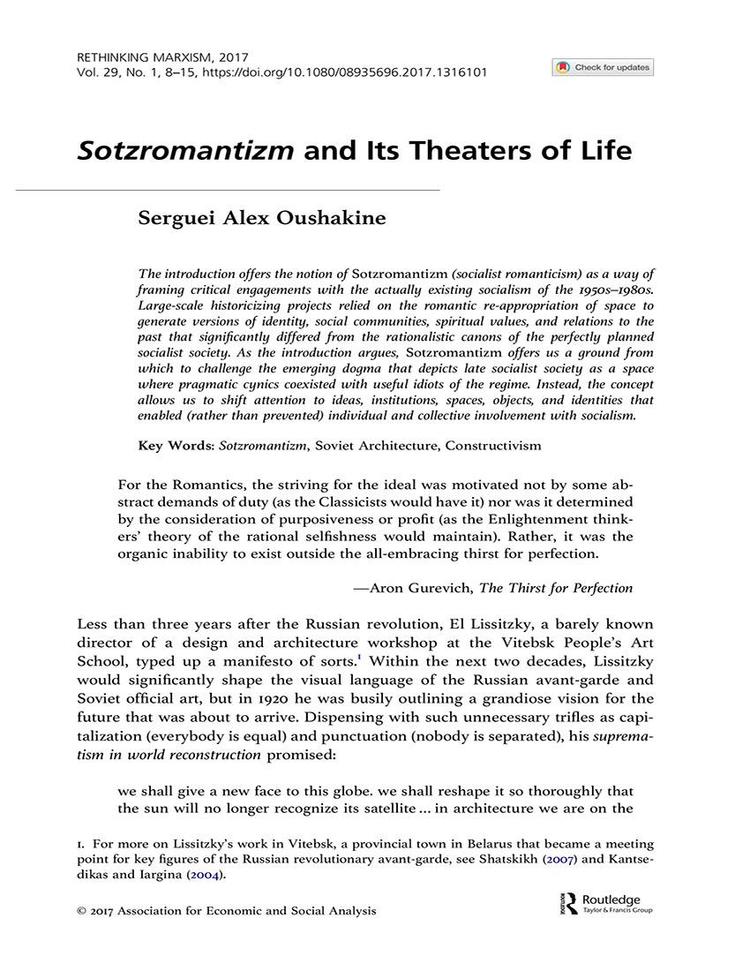Image

Symposium: "Landscapes of Socialism: Romantic Alternatives to Soviet Enlightenment," ed. by Serguei Oushakine (Rethinking Marxism, Vol.29, No 1, 2017)
Publication Year
2017
Type
Journal Article
Abstract
At a time such as this one, the constant need to reflect on historical and present forms of organizing space, along with the intimate and complex connections of these forms with social transformation, becomes more acute. The contents of the first issue of volume 29 of Rethinking Marxism are reflections on the relation between space and society. They all explore how the imaginations of particular historical eras take shape in space. In that spirit, we start the volume with a symposium, “Landscapes of Socialism: Romantic Alternatives to Soviet Enlightenment,” edited by Serguei A. Oushakine, on architecture, art, and landscape design in former socialist countries, and exploring the relation between these historical forms and transformations in society.
In “Sotzromantizm and Its Theaters of Life,” Serguei A. Oushakine contextualizes the contributions to the symposium. He starts his narrative with a reference to a visionary of Soviet architecture, to El Lissitzky’s manifesto, wherein the leading constructivist set out the spatial imagination of suprematism, which would shape the new world of socialism. In this utterly radical imagining, the reshaping of the world would take place through the “rhythmic” dissection of space and time into meaningfully organized units, which would move together with the transformation of the tools of representation, resulting in what Lissitzky named a “new theater of life.” Oushakine argues that the utopian radicalism of the constructivists remained—despite the industrialization embarked on in 1928—with leading architects such as Moisei Ginzburg and Mikhail Barshch designing Moscow as a “green city” that would be transformed into a huge park; this would be realized in an economical way with a view to solving the problems of the big city, such as dense traffic.
The new imagination represented both a desire for a radical break with and erasure of the past and also a refusal to inherit. The contributions to the symposium, argues Oushakine, develop more critical and complex stories of this “historical nihilism” of Soviet modernity. Each points to how this original refusal to claim history gave way to historicizing and historicist perspectives. These disparate ways of alluding to the past are aggregated under the name of Sotzromantizm, in which the spatial vision of early Soviet modernity synthesized with influences of the past, a seminal reference being made by Anna Elistratova in 1957 when the author questioned Socialist realism, pointing at the romantic traditions as possible sources of inspiration. Sotzromantizm, argues Oushakine, flowed in the works of architects, artists, and writers in diverse forms, creating a new “politico-poetical theater of life” and along the way providing alternatives to the rationalism of Soviet Enlightenment.
In “Sotzromantizm and Its Theaters of Life,” Serguei A. Oushakine contextualizes the contributions to the symposium. He starts his narrative with a reference to a visionary of Soviet architecture, to El Lissitzky’s manifesto, wherein the leading constructivist set out the spatial imagination of suprematism, which would shape the new world of socialism. In this utterly radical imagining, the reshaping of the world would take place through the “rhythmic” dissection of space and time into meaningfully organized units, which would move together with the transformation of the tools of representation, resulting in what Lissitzky named a “new theater of life.” Oushakine argues that the utopian radicalism of the constructivists remained—despite the industrialization embarked on in 1928—with leading architects such as Moisei Ginzburg and Mikhail Barshch designing Moscow as a “green city” that would be transformed into a huge park; this would be realized in an economical way with a view to solving the problems of the big city, such as dense traffic.
The new imagination represented both a desire for a radical break with and erasure of the past and also a refusal to inherit. The contributions to the symposium, argues Oushakine, develop more critical and complex stories of this “historical nihilism” of Soviet modernity. Each points to how this original refusal to claim history gave way to historicizing and historicist perspectives. These disparate ways of alluding to the past are aggregated under the name of Sotzromantizm, in which the spatial vision of early Soviet modernity synthesized with influences of the past, a seminal reference being made by Anna Elistratova in 1957 when the author questioned Socialist realism, pointing at the romantic traditions as possible sources of inspiration. Sotzromantizm, argues Oushakine, flowed in the works of architects, artists, and writers in diverse forms, creating a new “politico-poetical theater of life” and along the way providing alternatives to the rationalism of Soviet Enlightenment.
Journal
Rethinking Marxism
Volume
29
Issue
1
Pages
8-198

